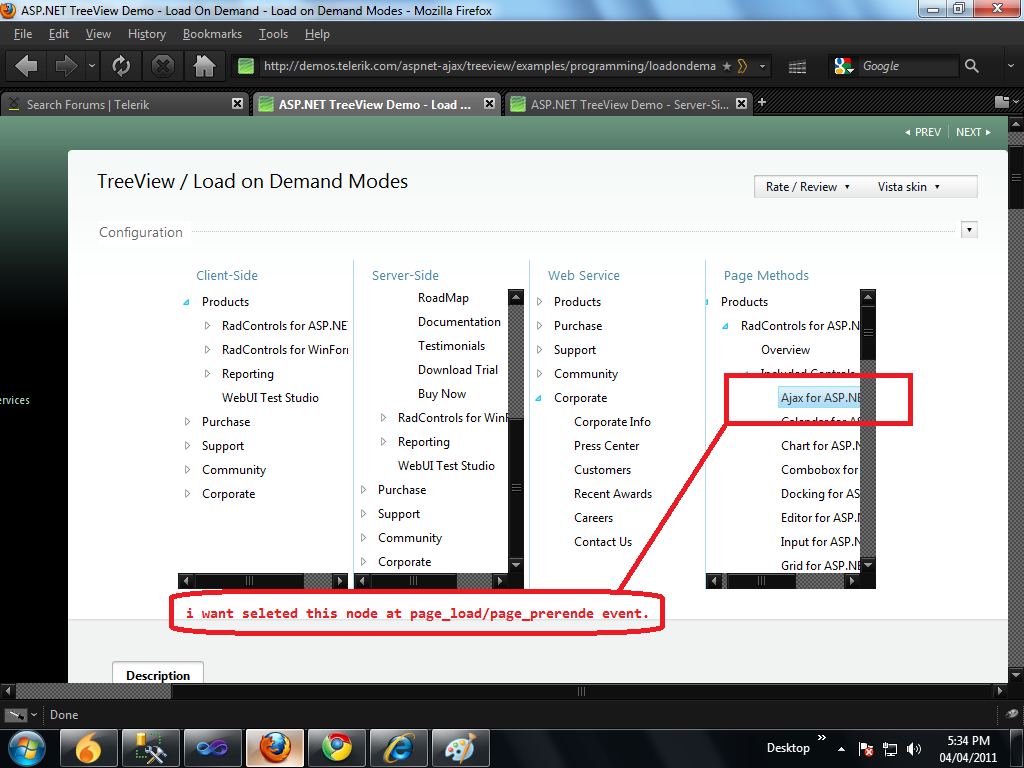

- #ASP.NET TREEVIEW EXAMPLES HOW TO#
- #ASP.NET TREEVIEW EXAMPLES CODE#
- #ASP.NET TREEVIEW EXAMPLES DOWNLOAD#
STEP-7: Write following Jquery code into the Page. Right Click on the treeview control > Go to properties > Set ShowCheckBoxes="All". Step-6: Add Property ShowCheckBoxes="All" into Treeview Control.įor Show checked treeview we need to set property ShowCheckBoxes="All". Now for 2nd task, we need to follow step 6 and 7. TreeNode newNode = new TreeNode(i.ToString(), i.ToString()) ĬreateTreeViewDataTable(dt, Convert.ToInt32(i), newNode) Private void CreateTreeViewDataTable(DataTable dt, int parentID, TreeNode parentNode)ĭataRow drs = dt.Select("ParentID = " + parentID.ToString()) SqlCommand cmd = new SqlCommand("Select * from MenuMaster", con)

Using (SqlConnection con = new Source=.\SQLEXPRESS AttachDbFilename=D:\Experiment\ASPTreeViewBinding\ASPTreeViewBinding\App_Data\MyDatabase.mdf Integrated Security=True User Instance=True")) TreeNode newnode = new TreeNode(i.MenuName, i.MenuID.ToString()) ĬreateTreeView(source, i.MenuID, newnode) List newSource = source.Where(a => a.ParentMenuID.Equals(parentID)).ToList() Private void CreateTreeView(List source, int parentID, TreeNode parentNode) Using (MyDatabaseEntities dc = new MyDatabaseEntities()) When you expand a node, the TreeView uses JavaScript to. NET MVC ASP NET,SQL Server, Vb Net Treeview Get Selected Node Customize the. Protected void Page_Load(object sender, EventArgs e) For example, consider the TreeView control, which lets users expand and collapse nodes at will. In this article Definition Examples Remarks Constructors Properties Methods. Second, 'subgroup1 and subgroup1' may be is a semantic error. Write the followings code in your page load event. Go to Solution Explorer > Right Click on Project name form Solution Explorer > Add > New item > Select web form/ web form using master page under Web > Enter page name > Add.

In your Razor HTML-view, the base for the TreeView control is a simple tag, with an data-url attribute pointing at the method it should call to get data: Īnd finally some javascript/jquery to initialize the TreeView and add some handling, this code loads the treeview, sets the icons I would like to have (from font-awesome) and adds a click-handler which just writes out the selected node name to the console.Go to Solution Explorer > Right Click on Project name form Solution Explorer > Add > New item > Select ADO.net Entity Data Model under data > Enter model name > Add.Ī popup window will come (Entity Data Model Wizard) > Select Generate from database > Next >Ĭhose your data connection > select your database > next > Select tables > enter Model Namespace > Finish. Return Json(list, JsonRequestBehavior.AllowGet) Var items = Directory.GetFileSystemEntries(node)

With ASPxTreeView, you can manually create a tree or easily populate it with data by binding to hierarchical data sources, including XmlDataSource and SiteMapDataSource. List.Add(new Node(Path.GetFileName(item), item, Directory.Exists(item))) ASPxTreeView is an easy and useful navigation control that allows you to represent hierarchical structure data as a tree. Var items = Directory.GetFileSystemEntries("D:/") The TreeView control is an object model in ASP.Net which allows creation of nodes dynamically. If it’s a folder I’m passing “true” to the load_on_demand property of the jqTree javascript model: public ActionResult Nodes(string node) This is some simple test-code using the local computer folder structure on the D-drive just to try it out. My action is called /Home/Nodes and takes and optional “node” parameter which holds the id of the treeview-node being “expanded”. 2 minutes to read TreeView represents a navigation control that displays a hierarchical collection of labeled items. Then create a controller method in HomeController.cs which will be called on-demand/lazily by the TreeView control in your HTML-view. This is the best, easiest, and fastest way to make tree view.
#ASP.NET TREEVIEW EXAMPLES HOW TO#
This article will guide you on how to display parent child tree view dynamically from the database. Public Node(string label, string id, bool loadOnDemand = true) TreeViewArticleSource.zip In this article, we will create a dynamic tree view menu fetched from the database, using ASP.NET MVC 5, C, Razor and SQL Server 2014 (using Visual Studio 2013). Then open up your /App_Start/BundlesConfig.cs file and add the files to your bundles, something like this:īundles.Add(new ScriptBundle("~/bundles/bootstrap").Include(īundles.Add(new StyleBundle("~/Content/css").Include(Īdd this viewmodel to hold the treeview node data: public class Node
#ASP.NET TREEVIEW EXAMPLES DOWNLOAD#
The package is not available on Nuget at the moment though, but it’s easy enough to download and set up manually.ĭownload and unzip the code from Github, copy the files jqtree.css and jqtree-circle.png to your /Content folder, and copy the file to your /Scripts folder. The code is available on and the author mbraak (Marco Braak) is very active in the “issues” section answering questions from users. I’ve been looking for a lightweight TreeView library to use with ASP.NET MVC, and I think I’ve found my “weapon of choice” – jqTree.


 0 kommentar(er)
0 kommentar(er)
